Strategy Development Tools for Competitive Advantage
VerifiedAdded on 2023/01/19
|7
|1740
|80
AI Summary
This essay evaluates strategy development tools like PESTEL, five forces, SWOT, and RBV and their effectiveness in helping companies develop business strategies. Examples of companies like IKEA, Amazon, Adidas, and Coca-Cola are used to illustrate the application of these tools. The essay concludes that these tools enable companies to generate a competitive advantage and navigate changing market conditions.
Contribute Materials
Your contribution can guide someone’s learning journey. Share your
documents today.
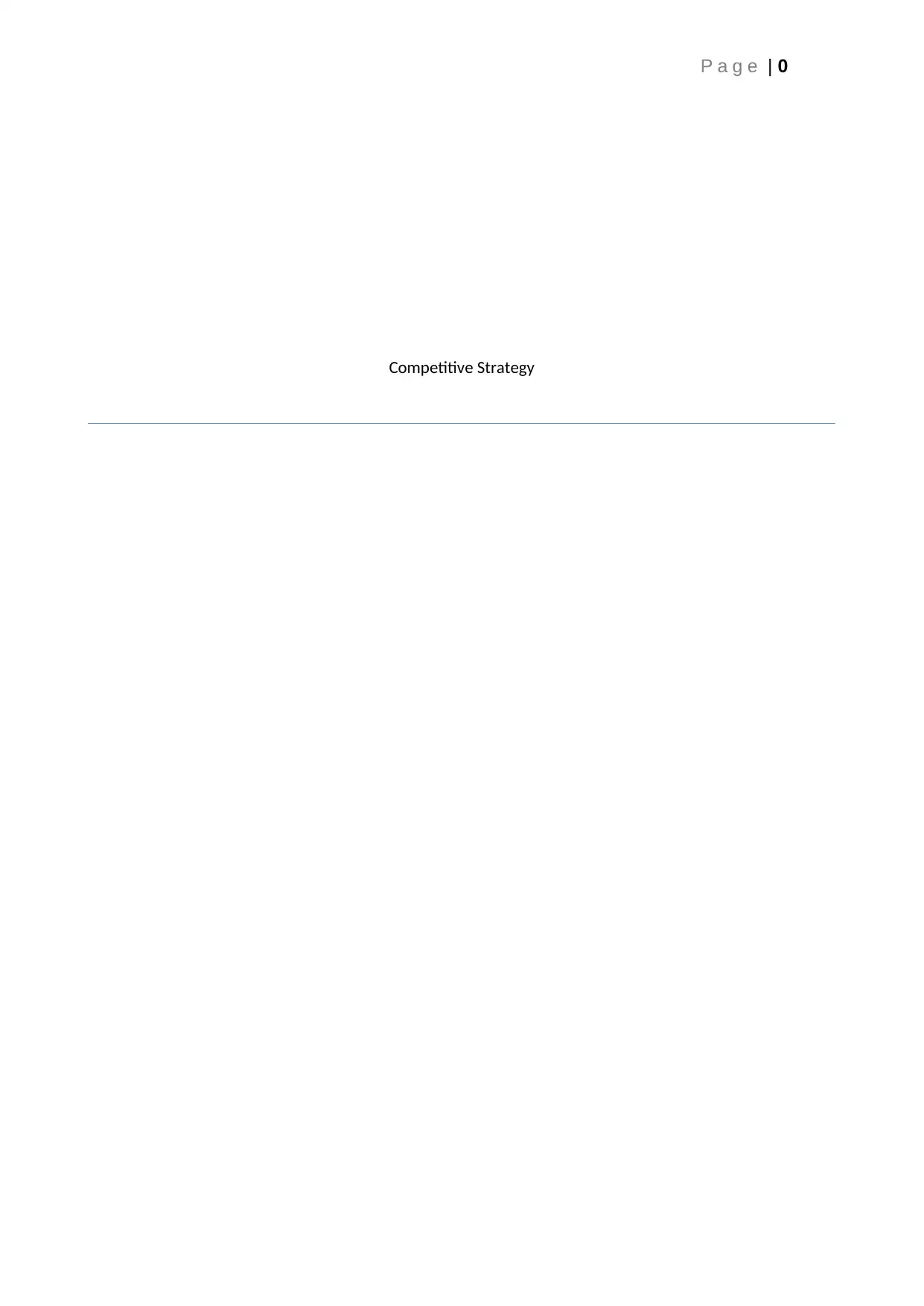
P a g e | 0
Competitive Strategy
Competitive Strategy
Secure Best Marks with AI Grader
Need help grading? Try our AI Grader for instant feedback on your assignments.
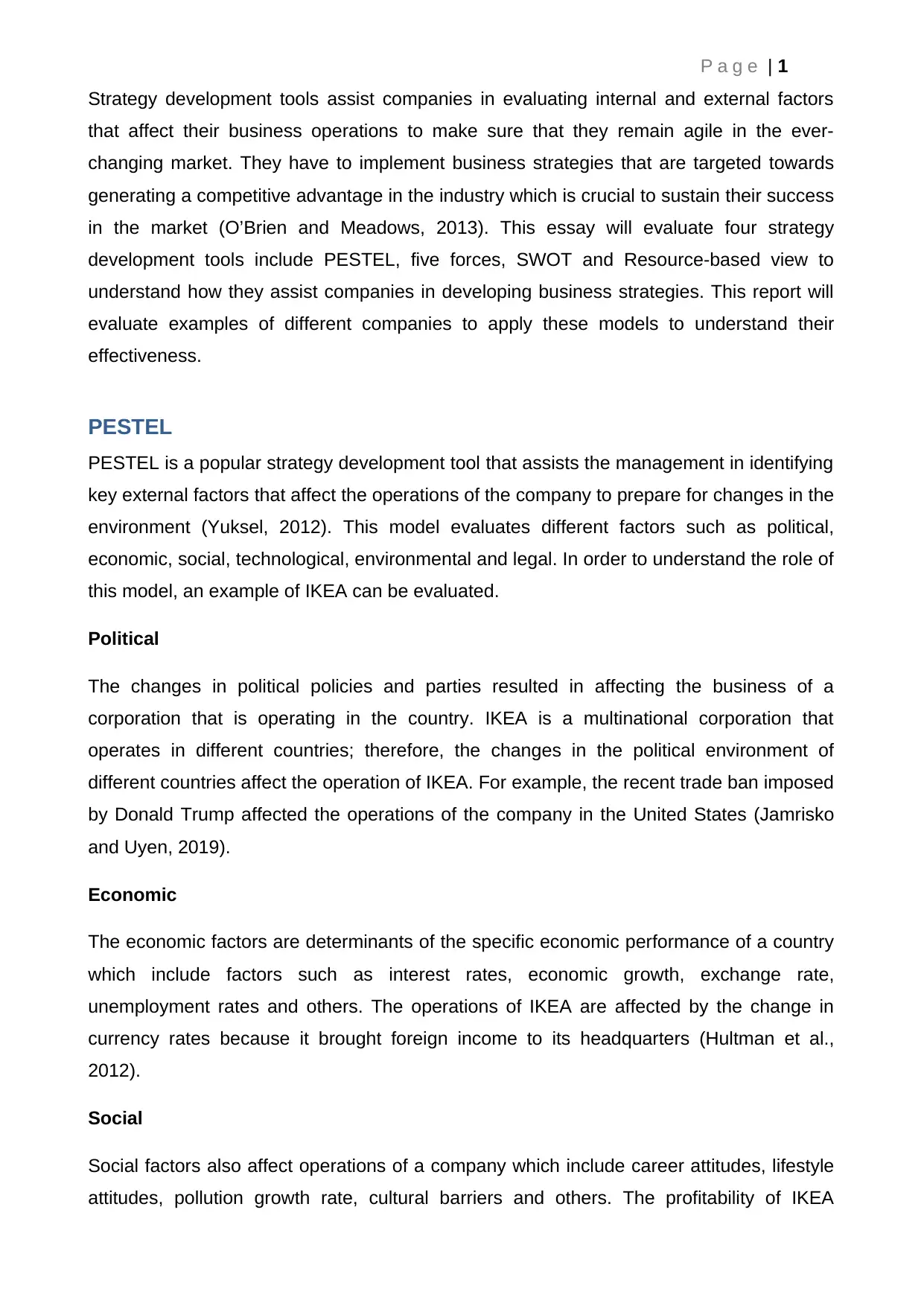
P a g e | 1
Strategy development tools assist companies in evaluating internal and external factors
that affect their business operations to make sure that they remain agile in the ever-
changing market. They have to implement business strategies that are targeted towards
generating a competitive advantage in the industry which is crucial to sustain their success
in the market (O’Brien and Meadows, 2013). This essay will evaluate four strategy
development tools include PESTEL, five forces, SWOT and Resource-based view to
understand how they assist companies in developing business strategies. This report will
evaluate examples of different companies to apply these models to understand their
effectiveness.
PESTEL
PESTEL is a popular strategy development tool that assists the management in identifying
key external factors that affect the operations of the company to prepare for changes in the
environment (Yuksel, 2012). This model evaluates different factors such as political,
economic, social, technological, environmental and legal. In order to understand the role of
this model, an example of IKEA can be evaluated.
Political
The changes in political policies and parties resulted in affecting the business of a
corporation that is operating in the country. IKEA is a multinational corporation that
operates in different countries; therefore, the changes in the political environment of
different countries affect the operation of IKEA. For example, the recent trade ban imposed
by Donald Trump affected the operations of the company in the United States (Jamrisko
and Uyen, 2019).
Economic
The economic factors are determinants of the specific economic performance of a country
which include factors such as interest rates, economic growth, exchange rate,
unemployment rates and others. The operations of IKEA are affected by the change in
currency rates because it brought foreign income to its headquarters (Hultman et al.,
2012).
Social
Social factors also affect operations of a company which include career attitudes, lifestyle
attitudes, pollution growth rate, cultural barriers and others. The profitability of IKEA
Strategy development tools assist companies in evaluating internal and external factors
that affect their business operations to make sure that they remain agile in the ever-
changing market. They have to implement business strategies that are targeted towards
generating a competitive advantage in the industry which is crucial to sustain their success
in the market (O’Brien and Meadows, 2013). This essay will evaluate four strategy
development tools include PESTEL, five forces, SWOT and Resource-based view to
understand how they assist companies in developing business strategies. This report will
evaluate examples of different companies to apply these models to understand their
effectiveness.
PESTEL
PESTEL is a popular strategy development tool that assists the management in identifying
key external factors that affect the operations of the company to prepare for changes in the
environment (Yuksel, 2012). This model evaluates different factors such as political,
economic, social, technological, environmental and legal. In order to understand the role of
this model, an example of IKEA can be evaluated.
Political
The changes in political policies and parties resulted in affecting the business of a
corporation that is operating in the country. IKEA is a multinational corporation that
operates in different countries; therefore, the changes in the political environment of
different countries affect the operation of IKEA. For example, the recent trade ban imposed
by Donald Trump affected the operations of the company in the United States (Jamrisko
and Uyen, 2019).
Economic
The economic factors are determinants of the specific economic performance of a country
which include factors such as interest rates, economic growth, exchange rate,
unemployment rates and others. The operations of IKEA are affected by the change in
currency rates because it brought foreign income to its headquarters (Hultman et al.,
2012).
Social
Social factors also affect operations of a company which include career attitudes, lifestyle
attitudes, pollution growth rate, cultural barriers and others. The profitability of IKEA
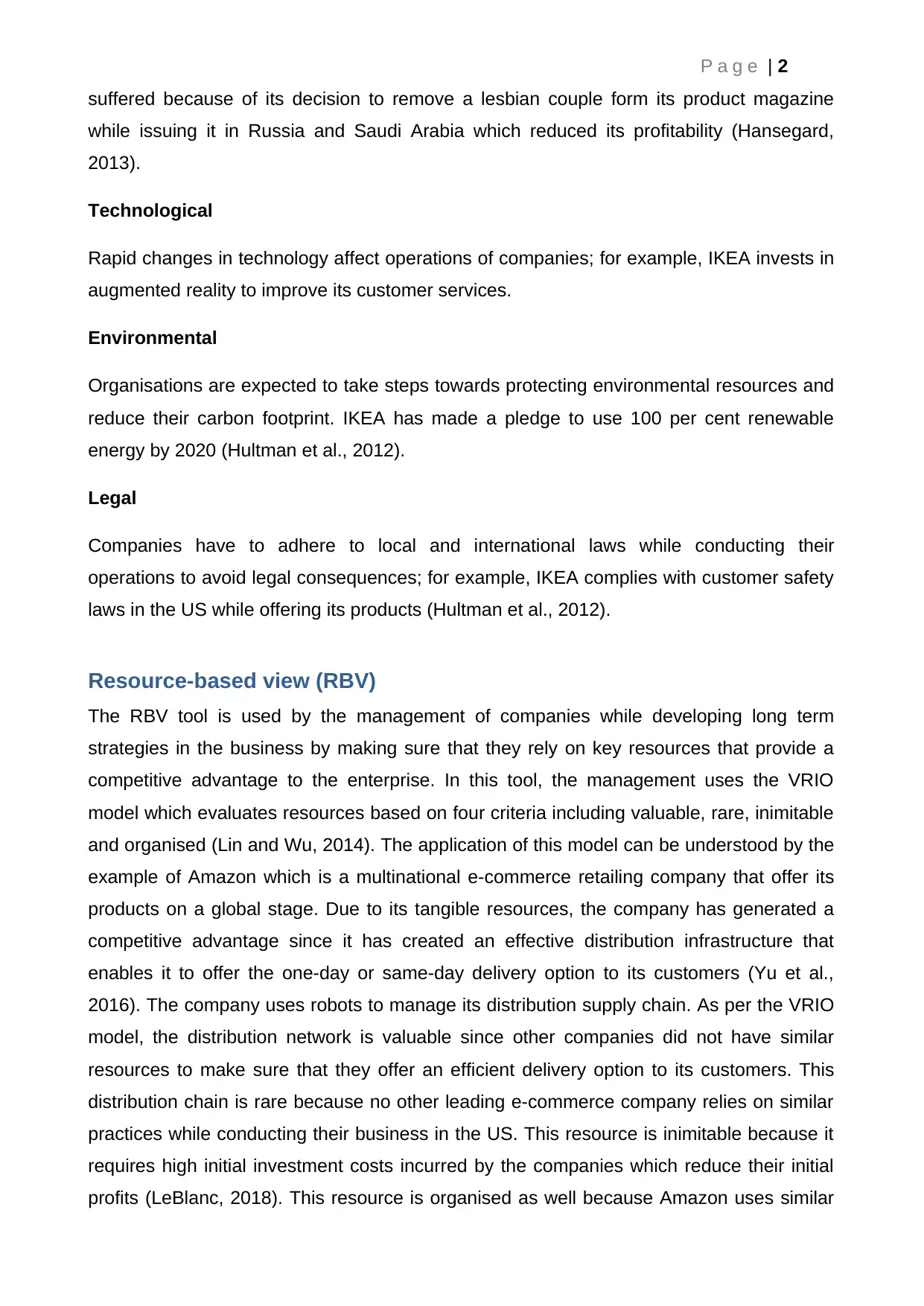
P a g e | 2
suffered because of its decision to remove a lesbian couple form its product magazine
while issuing it in Russia and Saudi Arabia which reduced its profitability (Hansegard,
2013).
Technological
Rapid changes in technology affect operations of companies; for example, IKEA invests in
augmented reality to improve its customer services.
Environmental
Organisations are expected to take steps towards protecting environmental resources and
reduce their carbon footprint. IKEA has made a pledge to use 100 per cent renewable
energy by 2020 (Hultman et al., 2012).
Legal
Companies have to adhere to local and international laws while conducting their
operations to avoid legal consequences; for example, IKEA complies with customer safety
laws in the US while offering its products (Hultman et al., 2012).
Resource-based view (RBV)
The RBV tool is used by the management of companies while developing long term
strategies in the business by making sure that they rely on key resources that provide a
competitive advantage to the enterprise. In this tool, the management uses the VRIO
model which evaluates resources based on four criteria including valuable, rare, inimitable
and organised (Lin and Wu, 2014). The application of this model can be understood by the
example of Amazon which is a multinational e-commerce retailing company that offer its
products on a global stage. Due to its tangible resources, the company has generated a
competitive advantage since it has created an effective distribution infrastructure that
enables it to offer the one-day or same-day delivery option to its customers (Yu et al.,
2016). The company uses robots to manage its distribution supply chain. As per the VRIO
model, the distribution network is valuable since other companies did not have similar
resources to make sure that they offer an efficient delivery option to its customers. This
distribution chain is rare because no other leading e-commerce company relies on similar
practices while conducting their business in the US. This resource is inimitable because it
requires high initial investment costs incurred by the companies which reduce their initial
profits (LeBlanc, 2018). This resource is organised as well because Amazon uses similar
suffered because of its decision to remove a lesbian couple form its product magazine
while issuing it in Russia and Saudi Arabia which reduced its profitability (Hansegard,
2013).
Technological
Rapid changes in technology affect operations of companies; for example, IKEA invests in
augmented reality to improve its customer services.
Environmental
Organisations are expected to take steps towards protecting environmental resources and
reduce their carbon footprint. IKEA has made a pledge to use 100 per cent renewable
energy by 2020 (Hultman et al., 2012).
Legal
Companies have to adhere to local and international laws while conducting their
operations to avoid legal consequences; for example, IKEA complies with customer safety
laws in the US while offering its products (Hultman et al., 2012).
Resource-based view (RBV)
The RBV tool is used by the management of companies while developing long term
strategies in the business by making sure that they rely on key resources that provide a
competitive advantage to the enterprise. In this tool, the management uses the VRIO
model which evaluates resources based on four criteria including valuable, rare, inimitable
and organised (Lin and Wu, 2014). The application of this model can be understood by the
example of Amazon which is a multinational e-commerce retailing company that offer its
products on a global stage. Due to its tangible resources, the company has generated a
competitive advantage since it has created an effective distribution infrastructure that
enables it to offer the one-day or same-day delivery option to its customers (Yu et al.,
2016). The company uses robots to manage its distribution supply chain. As per the VRIO
model, the distribution network is valuable since other companies did not have similar
resources to make sure that they offer an efficient delivery option to its customers. This
distribution chain is rare because no other leading e-commerce company relies on similar
practices while conducting their business in the US. This resource is inimitable because it
requires high initial investment costs incurred by the companies which reduce their initial
profits (LeBlanc, 2018). This resource is organised as well because Amazon uses similar

P a g e | 3
practices to manage its operations in major markets such as the US, Australia, the UK and
India to make sure that it offers efficient product deliver the option to its customers.
Five forces framework
The five forces framework was developed by Michael Porter in which he identified five
factors that can be evaluated by the management in order to determine the attractiveness
or unattractiveness of the market. By evaluating these factors, companies can formulate
strategies while launching their products in new markets or analysing the competitive of
the current market (Dobbs, 2014). These five factors include the bargaining power of
customers, suppliers, the threat of new entrants, the threat of substitution and competitive
rivalry. The application of this model can be understood through an example of Adidas
which is a multinational company that offers a wide range of apparel and accessories
products to its customers. The bargaining power of suppliers is low in the industry since
the company has formed contracts with different suppliers that are bound by the terms of
the contracts. Customers’ bargaining power is high since they did not have to pay
switching costs and they can purchase other products at competitive prices (Dong et al.,
2012). The threat of new entrants in the industry is low since new corporations have to
make high initial investments to establish their operations. The threat of substitute
products is low because Adidas relies on the innovate approach to fulfil the demand of its
customers and they did not receive similar quality from other manufacturers. Competitive
rivalry in the industry is high because of already established brands such as Nike, Puma
and Reebok.
SWOT Analysis
SWOT is one of the most popular strategy development tools that assist the management
in identifying key strengths, weaknesses, opportunities and threats of the company. This
tool enables the management in evaluating both internal and external factors to make sure
that companies rely on their strengths to increase their profitability which is crucial to
exploit key opportunities in the market (Yuan, 2013). It is important that the companies
must identify these factors to identify key weaknesses and threats of the company to
leverage their strengths to exploit opportunities of the business. The application of this tool
can be understood by an example of Coca-Cola which is a leading soft drink manufacturer
that offers its products worldwide. Strengths of the company include positive brand
reputation and already established production, distribution and marketing framework.
practices to manage its operations in major markets such as the US, Australia, the UK and
India to make sure that it offers efficient product deliver the option to its customers.
Five forces framework
The five forces framework was developed by Michael Porter in which he identified five
factors that can be evaluated by the management in order to determine the attractiveness
or unattractiveness of the market. By evaluating these factors, companies can formulate
strategies while launching their products in new markets or analysing the competitive of
the current market (Dobbs, 2014). These five factors include the bargaining power of
customers, suppliers, the threat of new entrants, the threat of substitution and competitive
rivalry. The application of this model can be understood through an example of Adidas
which is a multinational company that offers a wide range of apparel and accessories
products to its customers. The bargaining power of suppliers is low in the industry since
the company has formed contracts with different suppliers that are bound by the terms of
the contracts. Customers’ bargaining power is high since they did not have to pay
switching costs and they can purchase other products at competitive prices (Dong et al.,
2012). The threat of new entrants in the industry is low since new corporations have to
make high initial investments to establish their operations. The threat of substitute
products is low because Adidas relies on the innovate approach to fulfil the demand of its
customers and they did not receive similar quality from other manufacturers. Competitive
rivalry in the industry is high because of already established brands such as Nike, Puma
and Reebok.
SWOT Analysis
SWOT is one of the most popular strategy development tools that assist the management
in identifying key strengths, weaknesses, opportunities and threats of the company. This
tool enables the management in evaluating both internal and external factors to make sure
that companies rely on their strengths to increase their profitability which is crucial to
exploit key opportunities in the market (Yuan, 2013). It is important that the companies
must identify these factors to identify key weaknesses and threats of the company to
leverage their strengths to exploit opportunities of the business. The application of this tool
can be understood by an example of Coca-Cola which is a leading soft drink manufacturer
that offers its products worldwide. Strengths of the company include positive brand
reputation and already established production, distribution and marketing framework.
Secure Best Marks with AI Grader
Need help grading? Try our AI Grader for instant feedback on your assignments.
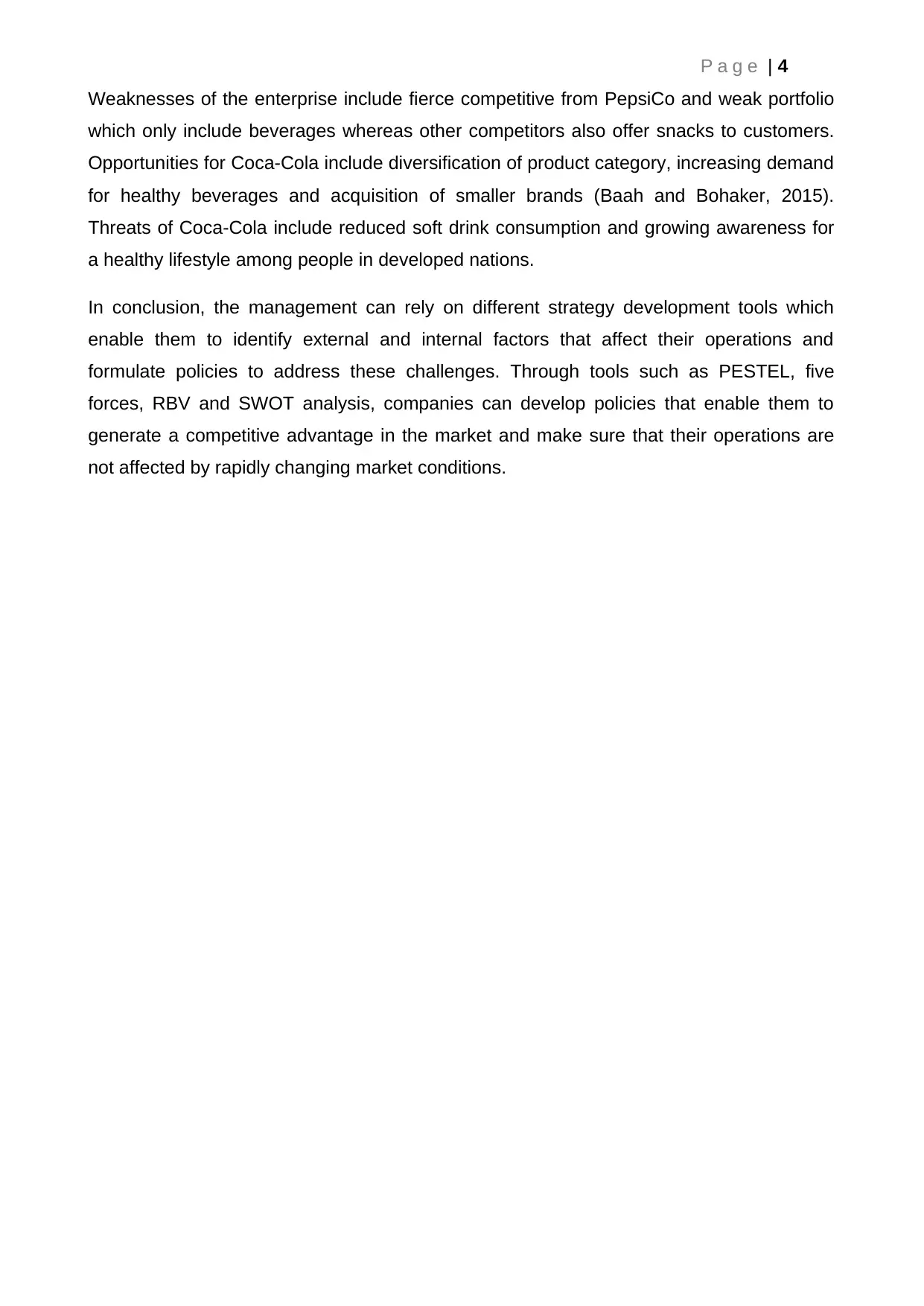
P a g e | 4
Weaknesses of the enterprise include fierce competitive from PepsiCo and weak portfolio
which only include beverages whereas other competitors also offer snacks to customers.
Opportunities for Coca-Cola include diversification of product category, increasing demand
for healthy beverages and acquisition of smaller brands (Baah and Bohaker, 2015).
Threats of Coca-Cola include reduced soft drink consumption and growing awareness for
a healthy lifestyle among people in developed nations.
In conclusion, the management can rely on different strategy development tools which
enable them to identify external and internal factors that affect their operations and
formulate policies to address these challenges. Through tools such as PESTEL, five
forces, RBV and SWOT analysis, companies can develop policies that enable them to
generate a competitive advantage in the market and make sure that their operations are
not affected by rapidly changing market conditions.
Weaknesses of the enterprise include fierce competitive from PepsiCo and weak portfolio
which only include beverages whereas other competitors also offer snacks to customers.
Opportunities for Coca-Cola include diversification of product category, increasing demand
for healthy beverages and acquisition of smaller brands (Baah and Bohaker, 2015).
Threats of Coca-Cola include reduced soft drink consumption and growing awareness for
a healthy lifestyle among people in developed nations.
In conclusion, the management can rely on different strategy development tools which
enable them to identify external and internal factors that affect their operations and
formulate policies to address these challenges. Through tools such as PESTEL, five
forces, RBV and SWOT analysis, companies can develop policies that enable them to
generate a competitive advantage in the market and make sure that their operations are
not affected by rapidly changing market conditions.
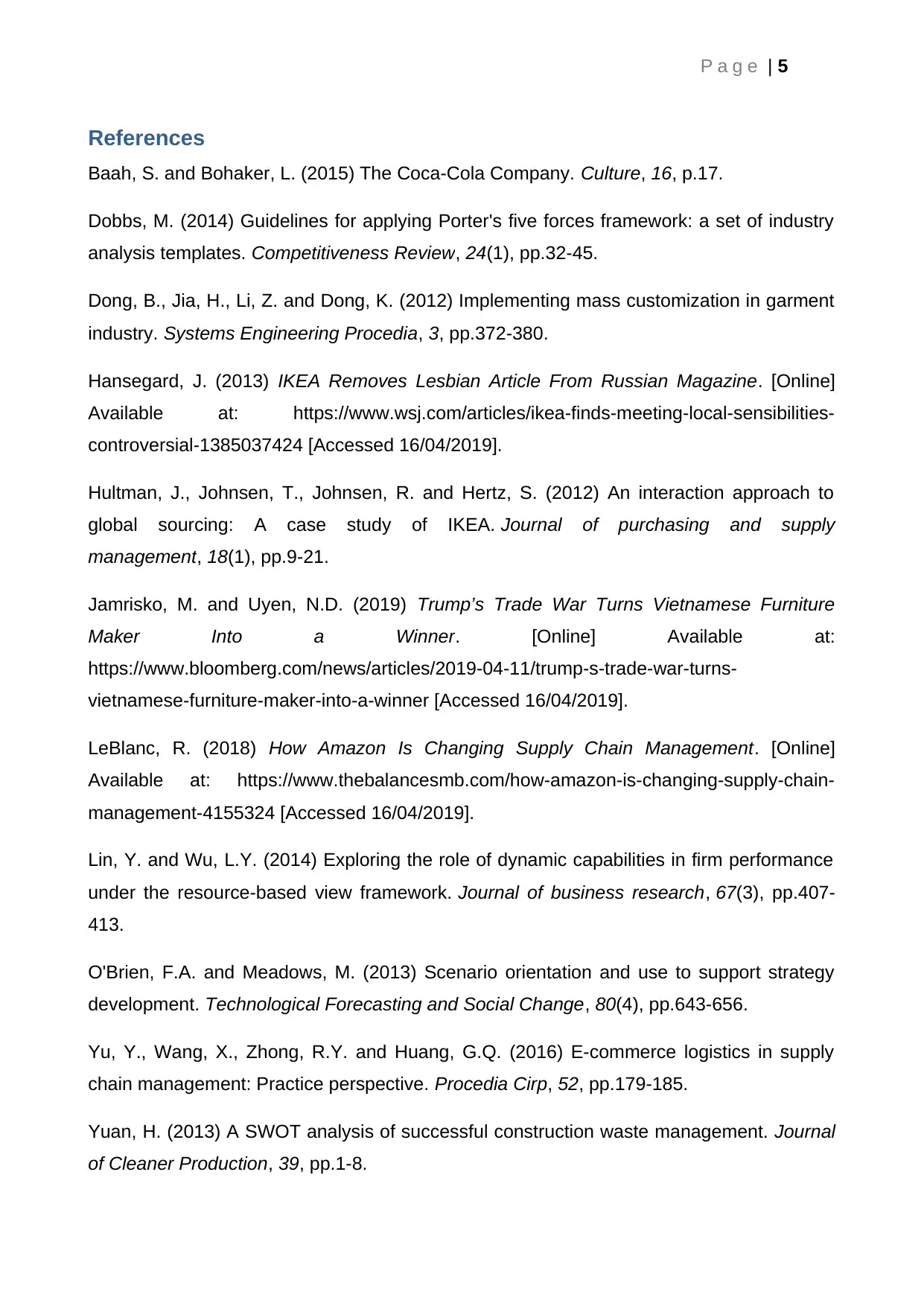
P a g e | 5
References
Baah, S. and Bohaker, L. (2015) The Coca-Cola Company. Culture, 16, p.17.
Dobbs, M. (2014) Guidelines for applying Porter's five forces framework: a set of industry
analysis templates. Competitiveness Review, 24(1), pp.32-45.
Dong, B., Jia, H., Li, Z. and Dong, K. (2012) Implementing mass customization in garment
industry. Systems Engineering Procedia, 3, pp.372-380.
Hansegard, J. (2013) IKEA Removes Lesbian Article From Russian Magazine. [Online]
Available at: https://www.wsj.com/articles/ikea-finds-meeting-local-sensibilities-
controversial-1385037424 [Accessed 16/04/2019].
Hultman, J., Johnsen, T., Johnsen, R. and Hertz, S. (2012) An interaction approach to
global sourcing: A case study of IKEA. Journal of purchasing and supply
management, 18(1), pp.9-21.
Jamrisko, M. and Uyen, N.D. (2019) Trump’s Trade War Turns Vietnamese Furniture
Maker Into a Winner. [Online] Available at:
https://www.bloomberg.com/news/articles/2019-04-11/trump-s-trade-war-turns-
vietnamese-furniture-maker-into-a-winner [Accessed 16/04/2019].
LeBlanc, R. (2018) How Amazon Is Changing Supply Chain Management. [Online]
Available at: https://www.thebalancesmb.com/how-amazon-is-changing-supply-chain-
management-4155324 [Accessed 16/04/2019].
Lin, Y. and Wu, L.Y. (2014) Exploring the role of dynamic capabilities in firm performance
under the resource-based view framework. Journal of business research, 67(3), pp.407-
413.
O'Brien, F.A. and Meadows, M. (2013) Scenario orientation and use to support strategy
development. Technological Forecasting and Social Change, 80(4), pp.643-656.
Yu, Y., Wang, X., Zhong, R.Y. and Huang, G.Q. (2016) E-commerce logistics in supply
chain management: Practice perspective. Procedia Cirp, 52, pp.179-185.
Yuan, H. (2013) A SWOT analysis of successful construction waste management. Journal
of Cleaner Production, 39, pp.1-8.
References
Baah, S. and Bohaker, L. (2015) The Coca-Cola Company. Culture, 16, p.17.
Dobbs, M. (2014) Guidelines for applying Porter's five forces framework: a set of industry
analysis templates. Competitiveness Review, 24(1), pp.32-45.
Dong, B., Jia, H., Li, Z. and Dong, K. (2012) Implementing mass customization in garment
industry. Systems Engineering Procedia, 3, pp.372-380.
Hansegard, J. (2013) IKEA Removes Lesbian Article From Russian Magazine. [Online]
Available at: https://www.wsj.com/articles/ikea-finds-meeting-local-sensibilities-
controversial-1385037424 [Accessed 16/04/2019].
Hultman, J., Johnsen, T., Johnsen, R. and Hertz, S. (2012) An interaction approach to
global sourcing: A case study of IKEA. Journal of purchasing and supply
management, 18(1), pp.9-21.
Jamrisko, M. and Uyen, N.D. (2019) Trump’s Trade War Turns Vietnamese Furniture
Maker Into a Winner. [Online] Available at:
https://www.bloomberg.com/news/articles/2019-04-11/trump-s-trade-war-turns-
vietnamese-furniture-maker-into-a-winner [Accessed 16/04/2019].
LeBlanc, R. (2018) How Amazon Is Changing Supply Chain Management. [Online]
Available at: https://www.thebalancesmb.com/how-amazon-is-changing-supply-chain-
management-4155324 [Accessed 16/04/2019].
Lin, Y. and Wu, L.Y. (2014) Exploring the role of dynamic capabilities in firm performance
under the resource-based view framework. Journal of business research, 67(3), pp.407-
413.
O'Brien, F.A. and Meadows, M. (2013) Scenario orientation and use to support strategy
development. Technological Forecasting and Social Change, 80(4), pp.643-656.
Yu, Y., Wang, X., Zhong, R.Y. and Huang, G.Q. (2016) E-commerce logistics in supply
chain management: Practice perspective. Procedia Cirp, 52, pp.179-185.
Yuan, H. (2013) A SWOT analysis of successful construction waste management. Journal
of Cleaner Production, 39, pp.1-8.
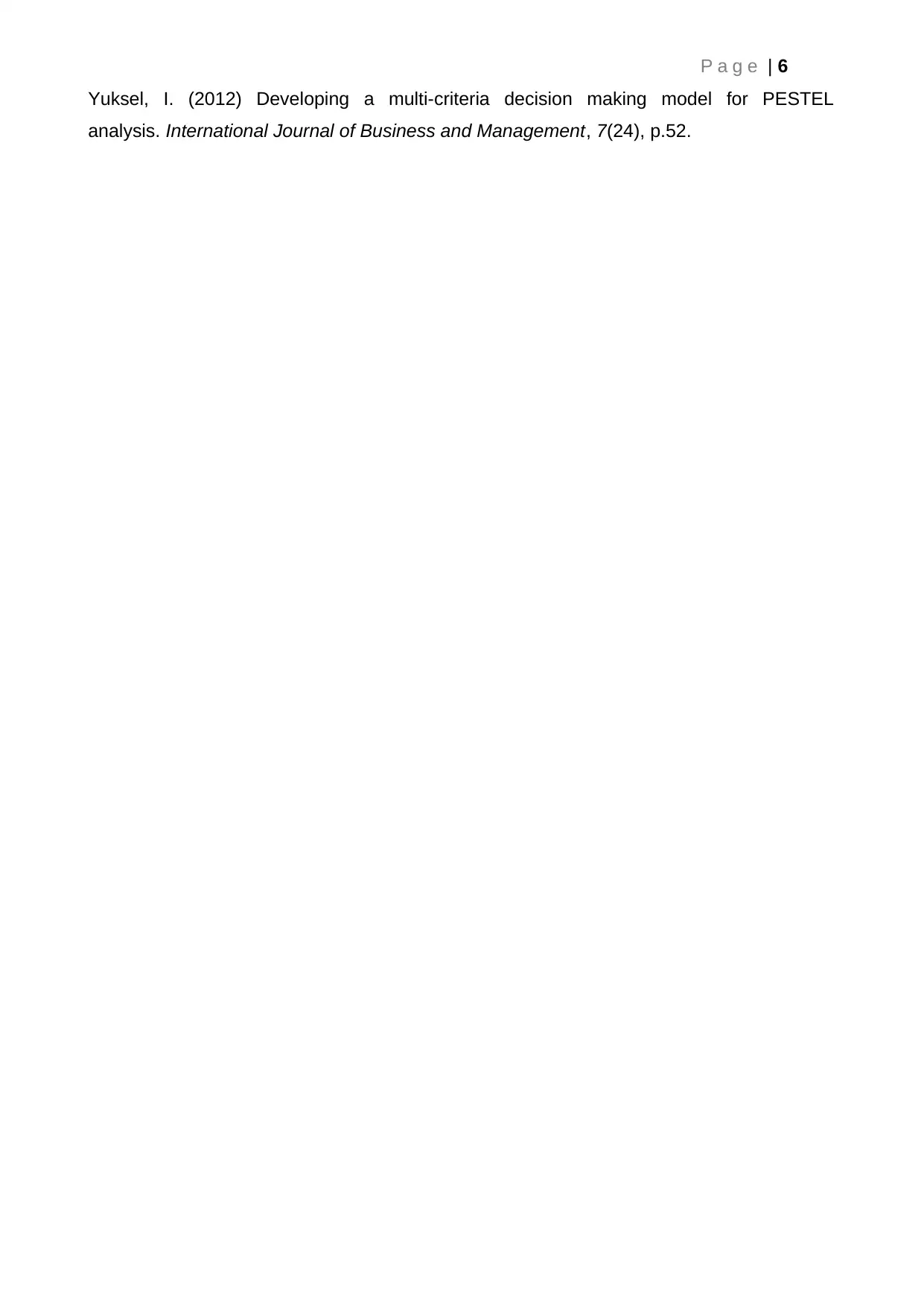
P a g e | 6
Yuksel, I. (2012) Developing a multi-criteria decision making model for PESTEL
analysis. International Journal of Business and Management, 7(24), p.52.
Yuksel, I. (2012) Developing a multi-criteria decision making model for PESTEL
analysis. International Journal of Business and Management, 7(24), p.52.
1 out of 7
Related Documents
Your All-in-One AI-Powered Toolkit for Academic Success.
+13062052269
info@desklib.com
Available 24*7 on WhatsApp / Email
![[object Object]](/_next/static/media/star-bottom.7253800d.svg)
Unlock your academic potential
© 2024 | Zucol Services PVT LTD | All rights reserved.



